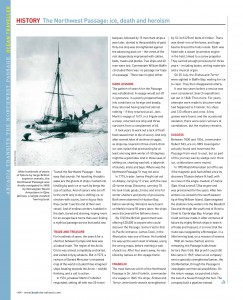The Northwest Passage: ice, death and heroism

Northwest Passage article from Boat International magazine
A short summary of the search for the route through the arctic ice, for Boat International magazine. A huge subject compressed semi-successfully to 1000 words! Original intro below:
Transit the Northwest Passage – how easy that sounds. Yet haunting Arcadia’s wake are the ghosts of ships crushed into kindling by pack ice or sunk by bergs the size of castles. And of sailors who set off to the north only to die in shifting ice, or stricken with scurvy, lost in fog so thick they couldn’t see the end of their own vessel. And of endless winters, huddled in the dark, bored and starving, hoping more for an escape back home than ever finding a mythical passage across that awful sea.
_________
Trade and treasure
For hundreds of years, the search for a shortcut between Europe and Asia was all about trade. The region of the Arctic Circle was almost completely uncharted, and visited only by whalers. But in 1572, a revision of Gerard Mercator’s renowned map of the world included three imagined ships heading towards the Arctic – wishful thinking, and a call to action.
In 1576, privateer Martin Frobisher responded, setting off with two 25-tonne barques, followed by 15 merchant ships a year later, alerted to the possibility of gold. Only one ship was strengthened against the advancing pack ice – the crews of the rest desperately improvised with cables, beds, masts and planks. Two ships and 40 men were lost. Commander William Baffin concluded there was ‘no passage nor hope of a passage’. There was no gold, either.
Hard lessons
The pattern of search for the Passage was established. A voyage would set off in ignorance, in a poorly prepared boat, into conditions so foreign and deadly, they returned having learned almost nothing – if they returned at all. Jens Munk’s voyage of 1619, in a frigate and a sloop, returned one ship and three survivors from a complement of 65.
It took years to work out a lack of fresh food caused men to die of scurvy. And only after several tales of onshore struggle, as ships lay covered in three-metre-thick ice, was it plain that provisioning for at least one long dark winter of -50 degrees might be a good idea. And in those seas of shifting ice, charting was hell: a labyrinth of islands, inlets and bays. Where was the Northwest Passage? It may not exist.
In 1715, trader James Knight set out on Albany, carrying 17 crew, with the new 40-tonne sloop Discovery, carrying 10. He took trade goods, bricks and lime for winter shelters and plenty of provisions. Both were observed in Hudson Bay, before vanishing. Remains were found on Marble Island 50 years later; the ships were discovered five fathoms down.
By 1745 the British government was offering £20,000 to anyone who could discover the Passage. Some tried to find its Pacific entrance; James Cook, in the Resolution, was one of these. He fumbled his way up the west coast of Alaska, using the wrong maps, before meeting a wall of pack ice. After four years away, he was killed by natives on the voyage home.
Franklin
The most famous victim of the Northwest Passage is Sir John Franklin, commander of a voyage in 1845. His ships, Erebus and Terror, were bomb vessels strengthened by 10-inch (25cm) belts of timber. There was sheet-iron at the bows, and huge beams braced the hulls inside. Each was fitted with a steam locomotive engine in the hold, linked to a screw propeller. They carried enough provisions for three years – including books, writing materials and a musical organ.
On 25 July, the Erebus and Terror were sighted in Baffin Bay, waiting for ice to clear. They then disappeared utterly.
It was two years before a rescue was even considered. Search expeditions set out in 1848. Then more. For years, attempts were made to discover what had happened to Franklin, his ships and 133 officers and crew. A few graves were found, and the occasional skeleton; there were even rumours of cannibalism, but the mystery remains.
Success
Between 1850 and 1854, commander Robert McLure on HMS Investigator actually found and traversed the Passage from west to east, but as part of the journey was by sledge over thick ice, celebrations were muted.
In 1903 Roald Amundsen set off to see if the magnetic pole had shifted since its discovery 70 years before (it had), with six crew on the single-masted, 47-tonne Gjøa. It had a small 13hp engine and was provisioned for five years. After two winters ice-locked to the south eastern tip of King William Island, Gjøa navigated the shallow rocky waters into the Beaufort Sea and through the south end of Victoria Strait to Cambridge Bay. A larger ship could not have made it. After centuries of failure by mighty British ships in search of trade and treasure, it is ironic that the route was navigated by a Norwegian, in a little herring boat, on a mission of science.
With all routes charted, and ice retreating, the Passage holds fewer terrors than it did. But proof it could still bite came in 1969, when an oil company sent a specially strengthened tanker, the SS Manhattan, through the Passage to investigate commercial possibilities. On the return voyage, ice punched a hole the size of a house through the hull. The company built a pipeline instead.
_________
Click here to see original PDF: